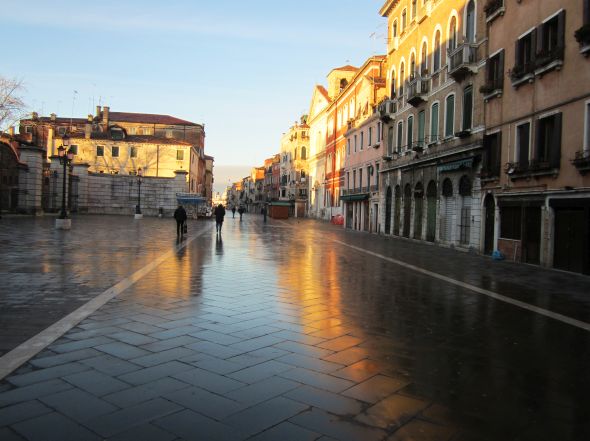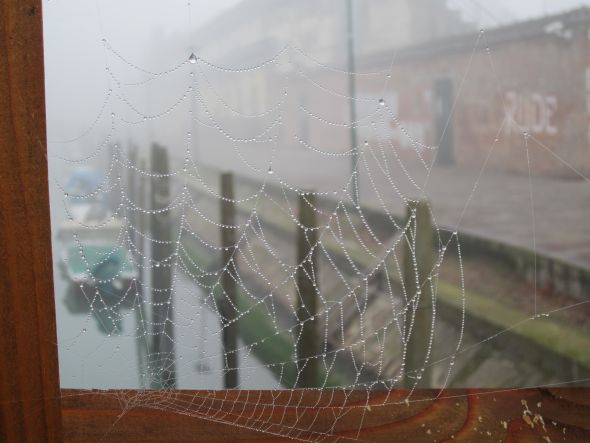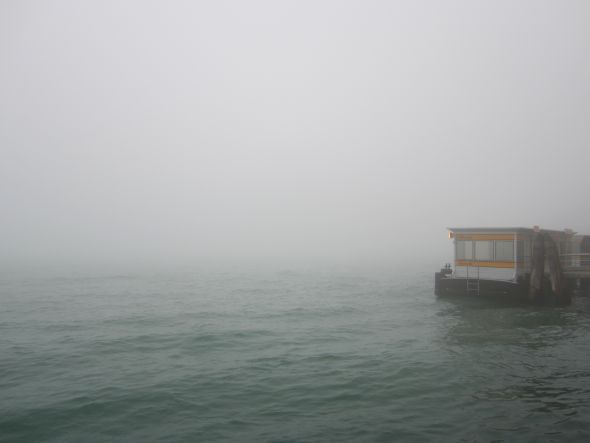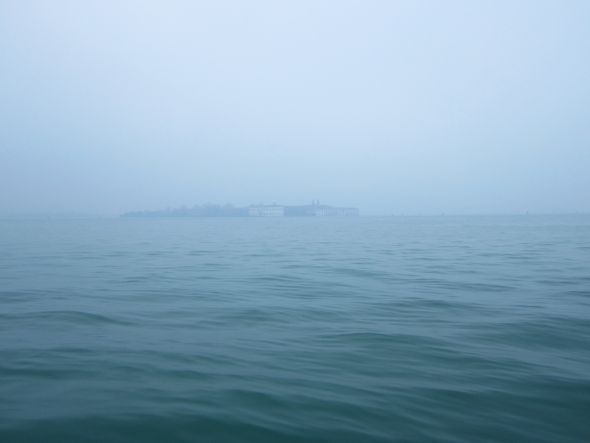The last time I saw the sun shine was January 6. It must have been a special gift from the Befana, one heck of a great stocking stuffer for the whole city. Here is what the morning of Epiphany looked like. Dwell long and lovingly upon it, because evidently we’re not going to see its like again, if the week that followed is any indication.

Well, that was wonderful. It was like falling in love; I wish it could have gone on forever. But the next morning fog took over and hasn’t left yet –the weather has become as tedious as Sheridan Whiteside, a/k/a “The Man Who Came to Dinner,” but not as amusing.
Because fog, whatever its density, wears out its welcome very fast. That’s just an expression; nobody welcomes fog. Water in the form of acqua alta is one thing; it may come, but you know it won’t be long before it goes. Water in the form of fog, when it’s not too heavy, is like an enormous sheet of grey gauze pulled across the face of the world, and you just have to put up with it until it’s gone, whenever that might be.

Fog can be dangerous, of course, but it is more commonly inconvenient — it compels the “GiraCitta'” round-the-city motoscafos to go up the Grand Canal instead of their usual routes. But where big fog is brawny, the lesser forms of airborne condensation are as monotonous as the droning of the Indian tanpura.
In Italian, there is nebbia and foschia; fog and mist. In Venice people refer to caligo (kah-EE-go), which I’ve only heard used to describe medium- to heavyweight fog. Caligo derives from caligine, which means “haze” (I discover that Caligo is also a genus of butterfly, but let’s stick to the weather). Technically, caligine is more like smog, which thankfully we don’t have here.
Call it what you will, it’s grey. Dingy grey, drab grey.
Fog lends itself to a particularly useful expression: “filar caligo” (fee-yar kah-EE-go) — to spin fog. If you are worrying about something, worrying in a particularly elaborate way about something you can’t fix — obsessively, silently, baffled, anxious, and so on — you would say (or some exasperated friend might well say) that you were drio a filar caligo. It’s the best expression I’ve ever heard for that particularly futile and gnawing kind of worry that drives everybody crazy. Many people do not reveal that they are in that state of mind precisely because they recognize its futility. But that doesn’t mean they can stop, any more than you can make the fog stop. It just has to go away on its own, usually when the wind changes, or when the thing you dread either comes to pass, or evaporates.

Charles Aznavour wrote (with F. Dorin) a song entitled “Que C’est Triste Venise” (Com’e’ Triste Venezia, or “How Sad is Venice”). That was 1964, and versions in Italian, English, Spanish, German and Catalan have come out since then. http://youtu.be/aMQ6GyUs-fc
In my opinion, that gave another push to the general idea that Venice is sad. Maybe it’s where the idea started. But while this song deals only with how sad the city is for the singer because his love is no longer with him, people seem to have concluded that the city itself is sad. Fog helps, of course. Cold and dark, even better.
I realize that if you are bereft of the love of your life because the relationship has ended, evidently against your will, and you had happy moments in Venice, of course you’re going to see your own sadness in the city. It’s natural. But somehow it seems that the received wisdom about Venice is that it has a particular affinity for melancholy. It might go just fine with the fog (and cold and dark). And I suppose Mr. Aznavour could have sung about how sad it is to be in Venice even if he’d been walking down via Garibaldi on Epiphany morning, when the world was coruscating with light, if all he had on his mind was his lapsed love affair.
But why should Venice have to be the world’s favorite sad city? You could just as credibly sing “How sad is Paducah.” “How sad is Agbogbloshie.” “How sad is Sanary-sur-Mer.” If you’ve lost your love, anywhere is going to feel like Venice in the fog.
There you’d be, wandering aimlessly around downtown Platte City, or wherever, repeating the song’s phrases which admittedly sound much better in French: “How sad is (fill in your town here), in the time of dead loves, how sad is (name here) when one doesn’t love anymore…And how one thinks of irony, in the moonlight, to try to forget what one didn’t say….Farewell, Bridge of Sighs (Susitna River Bridge, Sarah Mildred Long Bridge, Sixth Street Viaduct), Farewell, lost dreams.”

So I’m going to risk saying something radical: Venice isn’t sad, and it doesn’t make people sad. Venice is just a city, like you and me and everybody who lives here and in Smederevo and Panther Burn and Poggibonsi, trying to figure out how to get from today to tomorrow without leaving too many dents and dings on the surface of life.
I’d like Mr. Aznavour to go find another city in which to remember his lost love. And I’d also like the fog to go somewhere else. One of my wishes is going to be fulfilled, eventually.

